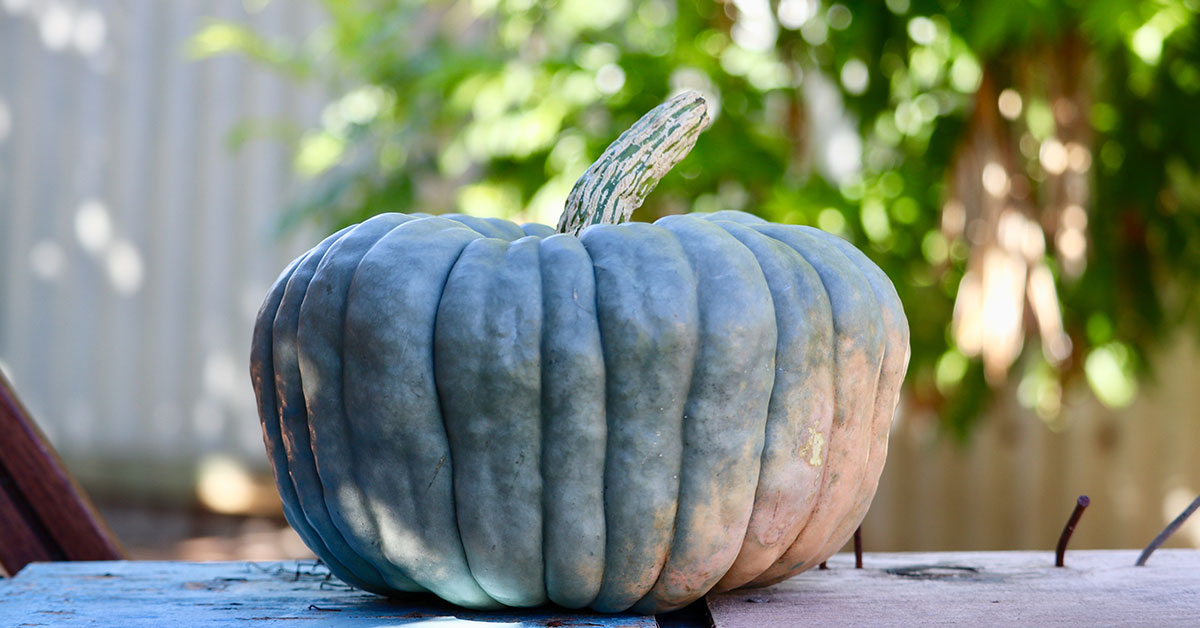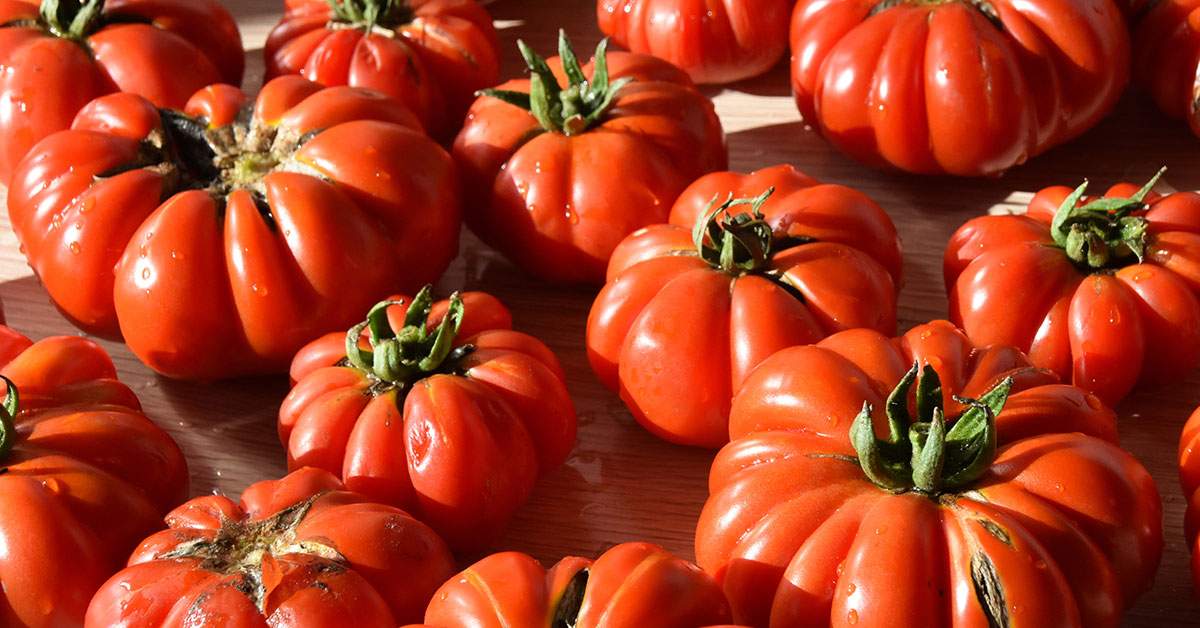The Australian Blue pumpkin is a unique and distinctive variety of pumpkin that is highly prized by chefs and foodies alike for its sweet, nutty flavor and striking blue-grey skin. It is a popular ingredient in a wide range of dishes, from hearty soups and stews to savory pies and tarts. Native to Australia, this pumpkin is now grown in many parts of the world and has become a beloved staple of the autumn harvest season. In this blog post, we’ll take a closer look at the Australian Blue pumpkin and explore its history, uses, and benefits.
What is an Australian Blue pumpkin?
Australian Blue pumpkin is a unique and eye-catching variety of pumpkin that is native to Australia. It is a winter squash that is known for its distinct blue-gray skin and sweet, nutty flavor. The pumpkin’s flesh is orange and dense, making it perfect for roasting, baking, or making soups and stews.
The Australian Blue pumpkin is also known as the Queensland Blue pumpkin, due to its origin in the Australian state of Queensland. It is a popular pumpkin variety in Australia, where it is grown both commercially and in home gardens. Its popularity has spread to other parts of the world, where it is becoming more widely available in specialty food stores and farmers’ markets.
The Australian Blue pumpkin is a great addition to any meal, whether as a side dish or as the main event. Its unique appearance and rich flavor make it a popular choice for fall and winter holiday dishes, such as pumpkin pie, pumpkin soup, and roasted pumpkin. If you are looking for a versatile and delicious pumpkin variety to add to your cooking repertoire, the Australian Blue pumpkin is definitely worth trying.
How to start Australian Blue pumpkin seeds
Growing pumpkins from seed is an incredibly rewarding and relatively easy gardening endeavor. With the right preparation and care, anyone can experience the joy of watching these vibrant vines produce bountiful, colorful pumpkins. Starting pumpkins from seed allows you to choose from a wide variety of shapes, sizes, and colors to suit your preferences.
Additional Resource: Our Full Guide On Starting Pumpkins From Seed
Growing & care
Caring for pumpkins is remarkably straightforward, making it an ideal choice for both novice and experienced gardeners. Once established, pumpkins require minimal maintenance.
- Transplanting: When the danger of frost has passed and the soil has warmed up, transplant the pumpkin seedlings into your prepared garden bed or large containers. Ensure they are spaced 3-5 feet apart to allow for proper growth and airflow.
- Care and Maintenance: Water your pumpkin plants deeply and regularly, aiming for about 1-2 inches of water per week. Mulch around the plants to conserve moisture and suppress weed growth. Monitor for pests and diseases, and take appropriate action if necessary.
- Pollination: Pumpkins require pollination for fruit set. Bees and other pollinators are crucial for this process. To encourage pollination, avoid using insecticides that could harm pollinators and consider hand-pollinating if necessary.
- Fertilization: As the pumpkin plants grow, provide them with regular feedings of balanced fertilizer according to the package instructions. This will help support healthy foliage growth and fruit development.
- Pruning and Training: Control the growth of your pumpkin vines by gently pruning back excessive foliage. This promotes better airflow and directs energy towards fruit production. Use trellises or supports to train the vines if desired.
- Harvesting: Harvest pumpkins when they reach their full color, have a hard rind, and the stem starts to dry out. Cut the pumpkins carefully from the vine, leaving a few inches of stem attached. Handle them gently to avoid any damage.
Common pumpkin pests and diseases
Growing pumpkins can sometimes encounter a few common problems. Here are some issues you may face and their corresponding solutions:
- Powdery Mildew: This fungal disease appears as a white, powdery coating on the leaves, causing them to wither and die. To combat powdery mildew, ensure proper spacing between plants for good air circulation. Apply fungicides as a preventive measure or use organic treatments like neem oil or a mixture of baking soda and water.
- Squash Bugs: These pests feed on the leaves, causing wilting and stunted growth. Handpick and destroy the bugs or use insecticidal soap to control their population. Placing floating row covers over young plants can prevent squash bugs from laying eggs.
- Vine Borers: The larvae of squash vine borers burrow into the stems, leading to wilting and plant death. Cut open the stem, remove the borer, and mound soil at the base of the affected plant to encourage rooting. Applying row covers early in the season can help prevent adult borers from laying eggs.
- Blossom End Rot: This physiological disorder manifests as sunken, darkened areas on the blossom end of the fruit. It is caused by calcium deficiency or inconsistent watering. Maintain consistent soil moisture levels, provide adequate calcium through organic amendments, and mulch around the plants to regulate soil moisture.
- Poor Fruit Set: Insufficient pollination can result in poor fruit development. Encourage pollinators by planting pollinator-friendly flowers nearby. In the absence of sufficient pollinators, hand-pollinate by transferring pollen from male to female flowers using a small brush or cotton swab.
- Overwatering or Root Rot: Excessive watering or poorly drained soil can lead to root rot and plant decline. Allow the soil to dry slightly between waterings, and improve drainage by amending the soil with organic matter or growing pumpkins in raised beds.
- Weeds: Weeds compete for nutrients, water, and sunlight, hampering pumpkin growth. Regularly weed around the plants to minimize competition and maintain a weed-free zone.
Remember to monitor your plants regularly, catch problems early, and apply appropriate treatments promptly. By implementing these preventive measures and taking swift action when needed, you can address common pumpkin-growing problems and enjoy a successful harvest.
Common problems
Growing Australian Blue pumpkin can be challenging, especially for beginners. There are several factors that can cause problems during the growing process. In this section, we will discuss some of the common problems that people encounter when growing Australian Blue pumpkin.
Pests
Pests are one of the most common problems that people face when growing Australian Blue pumpkin. The pumpkin plant attracts several pests, including aphids, squash bugs, and cucumber beetles. These pests can cause significant damage to the plant, causing stunted growth and reduced yields.
To prevent pest infestations, it is essential to practice good garden hygiene. Keep the garden clean and free of debris that can attract pests. You can also use natural pesticides such as neem oil or insecticidal soap to keep pests under control.
Diseases
Diseases are another common problem that can affect the growth of Australian Blue pumpkin. Powdery mildew, downy mildew, and bacterial wilt are some of the common diseases that can infect the plant. These diseases can cause foliage to yellow, wilt, and eventually die.
To prevent diseases, it is crucial to practice good garden hygiene. Remove infected leaves and dispose of them properly. You can also use fungicides to treat infected plants.
Soil Problems
Soil problems can also affect the growth of Australian Blue pumpkin. Poor soil drainage can cause waterlogging, leading to root rot and stunted growth. Soil nutrient deficiencies can also cause poor growth and reduced yields.
To prevent soil problems, it is essential to ensure that the soil is well-draining and rich in nutrients. You can add organic matter such as compost or aged manure to improve soil fertility. You can also test the soil to determine nutrient deficiencies and add fertilizers accordingly.
In conclusion, growing Australian Blue pumpkin can be a rewarding experience. However, it is essential to be aware of the common problems that can occur during the growing process. By practicing good garden hygiene and taking preventive measures, you can ensure a successful harvest of delicious and nutritious Australian Blue pumpkins.
When to harvest Australian Blue pumpkins
The Australian Blue pumpkin is a popular variety known for its unique blue-grey skin and delicious sweet flesh. It is a winter squash that takes about 100-120 days to mature. Harvesting at the right time is crucial to ensure the pumpkin is at its peak flavor and texture.
The first thing to look for is the color of the skin. When the pumpkin is fully ripened, the skin will turn a deep blue-grey color. If the skin is still green, it is not yet ready for harvest. Another sign to look for is the hardness of the skin. A mature pumpkin will have a hard, tough skin that is difficult to puncture with your fingernail.
The stem of the pumpkin is also a good indicator of its readiness for harvest. When the pumpkin is mature, the stem will begin to dry out and turn brown. This is a sign that the pumpkin is no longer drawing nutrients from the stem and is ready to be picked.
It is important to harvest the pumpkin before the first frost, as this can damage the skin and affect the quality of the flesh. To harvest the pumpkin, use a sharp knife or pruning shears to cut the stem about 2-3 inches above the pumpkin. Be careful not to damage the pumpkin or the stem as this can lead to rotting.
Once the pumpkin is harvested, it should be stored in a cool, dry place for at least a week to allow the skin to harden and the flavors to develop. After this, it can be stored in a cool, dark place for up to 3 months.
In conclusion, harvesting the Australian Blue pumpkin at the right time is essential to ensure it has the best flavor and texture. Look for the blue-grey skin, tough skin, and brown stem as indicators of maturity. Harvest before the first frost and store in a cool, dry place for optimal results.
Uses for Australian Blue pumpkins
Australian Blue pumpkin, also known as Queensland Blue, is a type of winter squash that is native to Australia. It is a popular ingredient in many Australian dishes and is widely used in various recipes due to its sweet and nutty flavor.
One of the most common uses of Australian Blue pumpkin is in soups and stews. Its rich flavor and texture make it an excellent ingredient for hearty and warming dishes during the cold winter months. It can also be roasted or baked and served as a side dish, or used as a filling for savory pies and pastries.
Another popular use of Australian Blue pumpkin is in salads. When sliced or diced, the pumpkin adds a vibrant burst of color to any salad, and its sweet flavor pairs well with tangy dressings and other vegetables.
In addition to its culinary uses, Australian Blue pumpkin is also a popular decorative item during the fall season. Its unique blue-gray skin and distinctive shape make it an attractive centerpiece for holiday displays and home decor.
Overall, Australian Blue pumpkin is a versatile ingredient that can be used in a variety of dishes. Its sweet and nutty flavor, combined with its unique appearance, make it a staple in many Australian kitchens.













